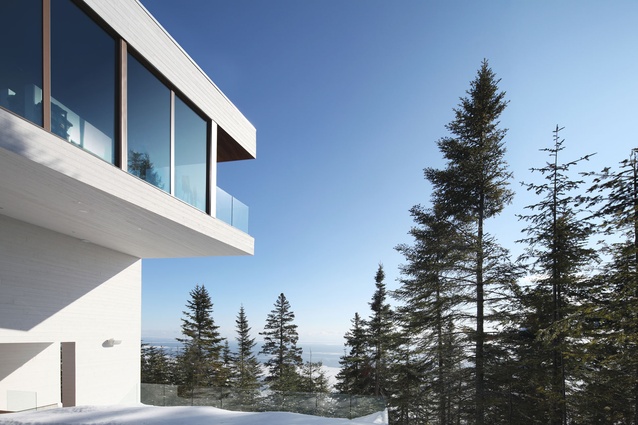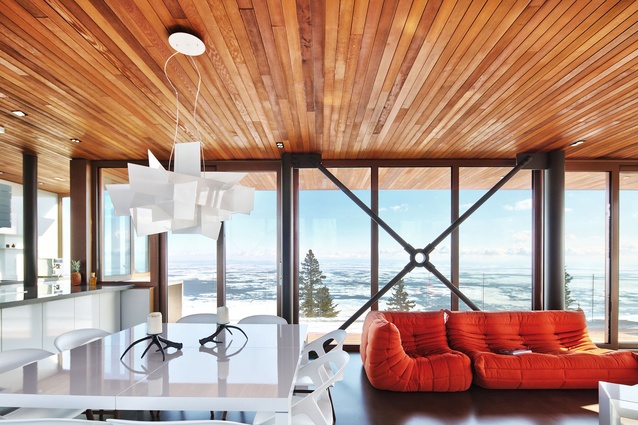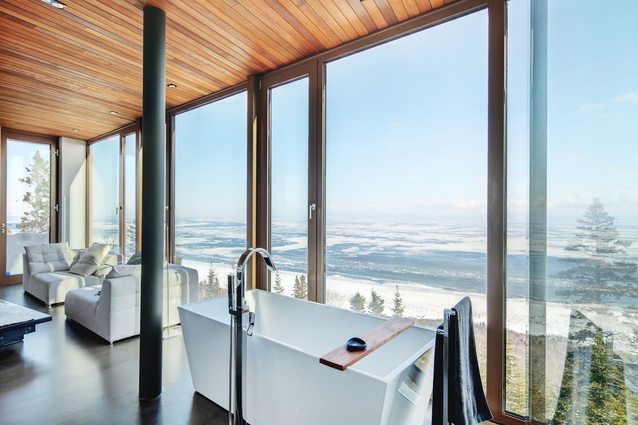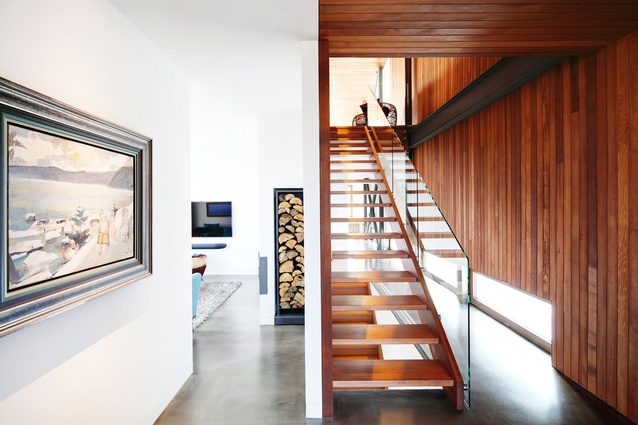Winter wonderland
A steeply sloping 3500m² section in Quebec’s rugged region of Charlevoix wasn’t ever going to be the easiest site to design a house around. So when Canadian architect Olivier Bourgeois was asked to design a “spectacular” new home for its owners, his response demanded thoughtful consideration.
“The winters are very harsh and the summers very hot in Quebec,” says Bourgeois. “So I had to design a dynamic form that would protect the house from both of these extreme weather conditions.”
His resulting three-levelled rectangular plan encompasses a generous 6225m² and comfortably accommodates the owners (a developer and restaurateur) and their two young children. The home’s imposing scale buffers the elements; a cantilever provides a protective overhang for the upper-level decks as well as coverage for the ground-floor swimming pool.
It also lends the house its most resounding design expression, while revealing Bourgeois’ primary influence.
“I worked for architect Todd Saunders in Bergen, Norway, before establishing my own practice three years ago and I always found the contrasting volumes in his villas so interesting,” explains Bourgeois. “The way he also manages to integrate his designs into the landscape displays a particular contemporary Nordic aesthetic that I try to incorporate into my own projects.”
That aesthetic means the house seems somewhat out of place in an area where traditional, chalet-style homes are de rigeuer. Bourgeois’ decision to paint the home’s cedar cladding white was made so that the dwelling would blend into the winter landscape and soften its verticality. (Interestingly, the local council requires all new homes built in the region to be clad in timber, a positive restriction introduced to support the local industry.) The only other concession to local convention is the modest street elevation; only the upper level is visible, while the two lower levels are hidden from view at the front.
The clients wanted an inviting home that catered to the needs of their growing family so Bourgeois created a children’s zone on the first level, which includes two bedrooms, a family room, a bathroom and a small study. The entry of the home, which is accessed via a footbridge, is also on this level, although it sits at the opposite end.
Throughout the house, the walls are painted white (punctuated by aluminium-framed windows and glass doors) and the floors are polished concrete. The black-and-white geometrically patterned tiles in the children’s bathroom add an element of visual interest as do the interior’s two stairwells lined in cedar. These vertical transitional spaces provide a visual link between the entry level and ground floor, which includes the owners’ home office and gym, and the upper-level living areas. The exposed cedar also adds warmth to an otherwise cool material palette and Bourgeois has extended this finish, utilising it as cladding for the ceiling in the upper level, where the master bedroom, ensuite, kitchen, dining room and living area are found.
“The owners want guests entering the upstairs living areas for the first time to be struck by the view and abundance of natural light,” he says. “There’s an element of surprise because it’s so uncommon in Quebec to open up a house in this way, with continuous floor-to-ceiling glass doors on three sides.”
By exposing the view so extensively, Bourgeois blurs the boundary between inside and outside. The furniture was chosen to complement, but not detract from, the phenomenal views. Plush blue and orange sofas and deep-burgundy-coloured armchairs fill the living areas. In contrast, stark-white furniture and furnishings have been chosen for the kitchen and master bedroom.
“Most of the furniture was new and chosen by myself and the owners specifically for this house,” he explains.
Bourgeois also had to incorporate a number of technical features that maintain levels of comfort throughout the house. Most significant is the in-floor heating system, made all the more effective because of concrete’s conductive properties. All of the glass is triple-glazed to provide insulation and a pulse-air system silently blasts these surfaces to prevent moisture build-up.
The heating systems may seem complicated but, without them, Bourgeois’ design could not have been realised. That the house’s construction took only 12 months to complete is a credit to its simplicity, which belies the visual complexity of the form. And the end result is a happy home, says Bourgeois: “The owners have generous space, impressive views and warm touches throughout. It’s a good place to live in.”
















